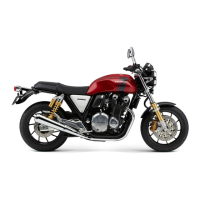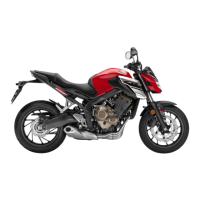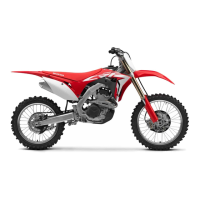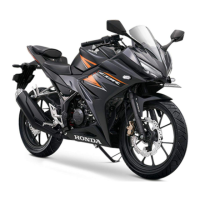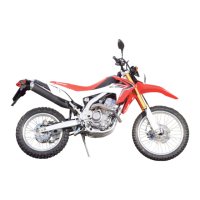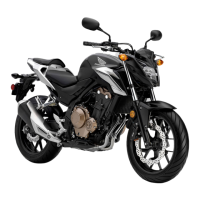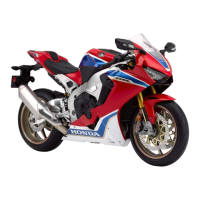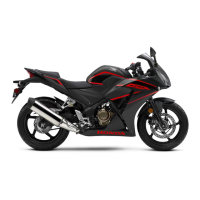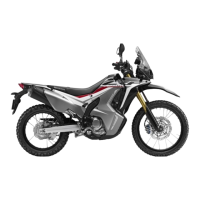Do you have a question about the Honda CMX500/A 2018 and is the answer not in the manual?
Follow safety guidelines for enhanced safety and riding pleasure.
Safety and information labels provide important safety information and warn of potential hazards.
Guidelines for rider and passenger safety, and protective apparel recommendations.
Guidelines for safe riding, including break-in, brakes, and riding within limits.
Advice on accessories/modifications to ensure safety and warranty.
Guidelines for carrying loads and passengers safely, including weight limits.
Check all display segments when the ignition is turned ON for proper function.
Details on odometer, tripmeter functions, and how to reset them.
How to change time format, clock, backlight brightness, and units.
Explains the PGM-FI malfunction indicator lamp and its behavior when illuminated.
Describes the high coolant temperature indicator and when it illuminates.
Explains the low oil pressure indicator and its behavior when the engine is running.
Explains the Anti-lock Brake System indicator and its operation.
Describes the neutral indicator light and its function.
Description of various switches located on the motorcycle handlebars.
How the ignition switch controls the electrical system and key removal.
Procedures for locking/unlocking the steering to prevent theft.
Recommended speeds for upshifting/downshifting gears for optimal performance.
Step-by-step instructions for opening the fuel fill cap.
Steps for properly closing the fuel fill cap after refueling.
Location and contents of the tool kit.
Location of the document bag for manuals and registration.
Explains why regular maintenance is crucial for safety and performance.
Details recommended maintenance intervals for motorcycle components.
General principles and procedures for performing motorcycle maintenance safely.
Step-by-step guide for replacing the air cleaner element.
Procedures for removing and installing the motorcycle battery.
Steps for removing and installing the motorcycle seat.
Procedures for removing and installing the side covers.
How to check the engine oil level using the inspection window.
Instructions for adding the correct amount of engine oil.
Step-by-step guide for changing engine oil and oil filter.
How to check the coolant level in the reserve tank.
Instructions for adding coolant to the reserve tank.
Procedure for changing the engine coolant.
How to check the brake fluid level in front and rear reservoirs.
How to inspect brake pads for wear using indicators.
How to adjust the brake light switch for proper operation.
How to check side stand operation and its safety feature.
How to check and measure the drive chain slack.
Step-by-step guide to adjust drive chain slack.
How to check drive chain wear using a wear label.
How to check the freeplay of the clutch lever.
Procedures for adjusting clutch lever freeplay.
How to check throttle operation and freeplay.
Steps to adjust the throttle grip freeplay.
Procedure for cleaning the crankcase breather.
How to adjust the vertical aim of the headlight.
How to adjust the spring preload on the rear shock absorbers.
Steps to diagnose and resolve issues when the engine won't start.
What to do if the engine overheats or the high coolant indicator is on.
Explains common warning lights and their potential causes.
Information on emergency tire repair and removing wheels.
Troubleshooting common electrical issues like dead battery or burnt bulbs.
Steps for checking and replacing blown fuses.
Information about ignition and steering lock keys.
Details on instruments, controls, ignition, and engine stop switches.
Guidelines for cleaning, polishing, and maintaining the motorcycle's appearance.
Recommendations for storing the motorcycle for extended periods.
How to safely transport the motorcycle.
Information on environmentally responsible practices.
Location of VIN and engine serial numbers.
Information on exhaust and noise emission control systems.
Function and maintenance of the catalytic converter.
Guidelines for using oxygenated fuels and their compatibility.
Information on ordering service and owner's manuals.
Details on warranty coverage, restrictions, and service procedures.
Contact information for American Honda Motor Co., Inc. and Honda Canada Inc.
How to report safety defects to NHTSA and Honda.
Key physical and performance specifications of the motorcycle.
Technical data for maintenance, including fluid capacities, tire specs, and spark plugs.
Specifications for all motorcycle bulbs.
Ratings for main and other fuses.
Torque values for various bolts and nuts during maintenance.
| Displacement | 471 cc |
|---|---|
| Compression Ratio | 10.7:1 |
| Fuel System | PGM-FI electronic fuel injection |
| Starter | Electric |
| Transmission | 6-speed |
| Final Drive | Chain |
| Front Tire | 130/90-16 |
| Rear Tire | 150/80-16 |
| Width | 820 mm |
| Seat Height | 690 mm |
| Wheelbase | 1, 490 mm |
| Ground Clearance | 130 mm |
| Fuel Capacity | 11.2 liters |
| Engine Type | Liquid-cooled parallel-twin four-stroke |
| Bore x Stroke | 67 mm x 66.8 mm |
| Max Torque | 44.6 Nm @ 6, 000 rpm |
| Front Suspension | 41 mm telescopic fork |
| Rear Suspension | Dual shock |
| Front Brake | Single disc |
| Rear Brake | Single 240mm disc with single-piston caliper |
| Curb Weight | 191 kg |
| Ignition | Computer-controlled digital transistorized with electronic advance |
